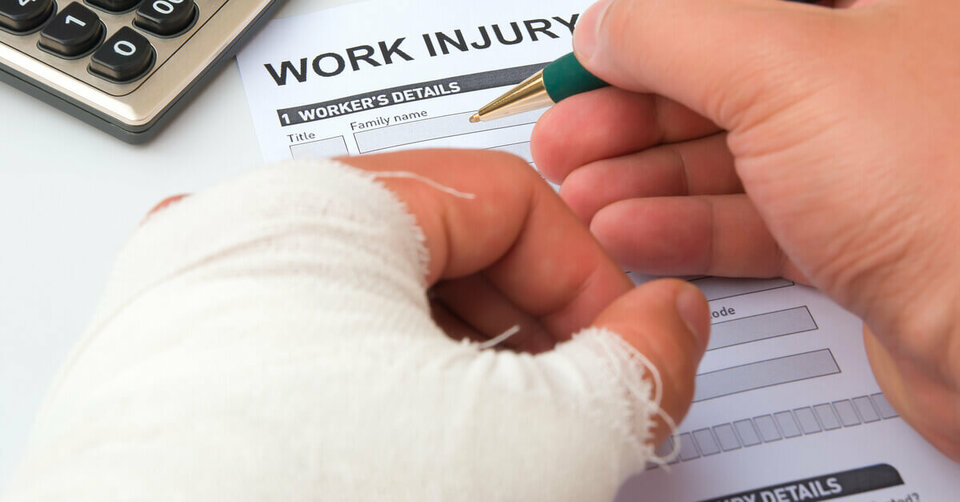What is an accident book and do I need one?
Fire extinguishers, first aid kits and an accident book – what do these three things have in common? Apart from creating a safe work space, they’re not exactly the things you rush out to get when starting a business.
The first two are probably going to be higher on your agenda when creating a safe office environment and are actually required by law, but did you know you might legally need a work accident book too?
What exactly is an accident book?
While a first aid kit comes in handy to the injured at the time, an accident book may help the wounded party and the business owner at a later date.
An accident book at work effectively logs every accident that occurs in the office or while an employee was out and about, but still on company time and acting for the business.
What should be recorded in an accident book?
It should include a description of how the accident happened, who was involved, what the injury was and the date and time that is happened.
This is the most basic information, however, for a much more detailed guide of what exactly needs to be recorded scroll down to our step-by-step guide.
An accident book isn’t just another Health and Safety regulation
Health and safety can often be a huge bugbear for business owners. So many measures and procedures, it’s enough to cause a headache, but an accident book can actually come in handy. When one is used, it can benefit both the employee and the employer. For starters, it shows the employer cares for their employees.
How can accident books be used by employees?
An accident book can act as a point of reference when explaining any time off work needed because of the injury. It can also support you if you decide to claim for compensation.
Why do employers need accident books?
A list of recorded accidents can indicate the types of changes that are needed around the office to improve the Health and Safety standards. If the same sorts of injuries keep cropping up, you as an employer should carry out a full risk assessment to get to the cause of the problem. For instance, if multiple employees have fallen off ladders, this might suggest some training is needed into ‘how to climb a ladder’ or looking at the common placement of said ladders and making this less accident prone.
In the eyes of the law...
An accident book is effectively a law-abiding book of evidence. If lawyers were to become involved in the resolution of a work accident debate, the accident book would be used in a legal claim as either proof that compensation is entitled or proof that the employee is milking it.
It is a way to cover everyone’s backs.

Are accident books needed in every office?
Let’s say you’re a start-up that’s just starting out and there are only a couple of you on board, so far. You don’t need an accident book until you’ve reached 10 employees in the business.
In an office with 10 or more people, it is required by law to have a work accident book in the building. Any information recorded in the book should be held onto, in a safe place by the business, for at least three years.
In offices with less than 10 people, you can choose not to have a book, but this is at your own risk. You’ll be sure that the sensible Sally on your shoulder is going to tell you that even if it’s not required, it’s probably a good idea to have one, just in case.
Papercut? Severed leg? What type of accidents should I be recording?
Let’s talk about a little legislation called RIDDOR. Ok, it’s not so little, it’s the ‘Reporting of Injuries, Diseases and Dangerous Occurrences Regulations 1995’. This states the types of accidents that should always be reported.
These include:
- Death
- Major injuries, like broken legs, ribs or arms (basically. anything that’s snapped).
- An injury that will stop an employee doing their work for 7 days or more. This law was changed in 2012, from 3 days. If an injury does still result in an employee being incapacitated for 3 days, this should still be recorded, but not necessarily reported under this legislation.
- Disease
- Appliances defecting which result in a dangerous incident. This includes machinery breaking, scaffolding collapsing etc.
These are the most severe cases and it only takes a bit of common sense to work out that these are the worst case scenarios and should always be reported. However, if you’re not sure of the severity of the accident, or just not sure in general if you should record it, the most sensible thing to do is log any injury in the accident book. This is just to be on the safe side, so to speak.
Funnily enough, this could mean recording such minor injuries as cut fingers, trips and falls and anything caused by office equipment that could be faulty. The smaller wounds can often be found to lead to bigger risks or a larger problem.

Who should fill out the accident book?
While it is perfectly legitimate for the injured party to fill out the accident book themselves, it is probably best done by a witness or a colleague. While you’d like to think the employee would be truthful and accurate when describing what happened, you never can be too careful.
The information kept should be strictly confidential. The way to resolve this is to enter each accident on a page-by-page basis. This means pages can be added and removed when an incident needs to be logged or an accident needs to be checked for legal reasons, keeping everyone else’s information safe in the process.
Who should I report an accident to?
The HSE (Health and Safety Executive) is Great Britain’s independent regulator for accidents at work. It is the public body responsible for the enforcement, encouragement and regulation of health, safety and welfare in the workplace.
Their super handy website has all the relevant information you need and the number you need to call when reporting a serious accident.
So this reporting process, take me through it step-by-step...
Before you even start to fill out the form, there are a few steps to take when an injury occurs…
- In the first instance of being alerted to an injured person (IP), check that the area you are about to go and help them is safe to enter.
- Give the necessary first aid if the injury is very severe.
- Notify the nearest member of management. This makes the employer aware and, with their knowledge of the current health and safety legislation, they should be able to take the best action based on this.
Filling out the form:
Record the IP’s personal information
This includes their name, sex, date of birth, occupation, number, email, home address, why the IP was at the location and whether they were a member of public at the time.
Record the form filler’s information
If you are filling out the form, this would be your personal information. This includes your name, position and contact details (as above). Details of the accident The date, time and location of the accident needs to be noted in this section.
Record details of the injury
Try and be as detailed as possible in this bit. Start with the part of the body that’s been injured. Then describe the type of injury, for instance, was it a burn? Bruise? Or maybe a fracture? Was the person conscious? Does the IP need to go to hospital? Did they go to the hospital in an ambulance? And finally, whether the IP was an employer and how many days off work they needed because of the accident (if any).
Witness details
It might be immediately obvious who the witness(es) is/are. If not, ask around and if there are any you should collect their name, number, email and address.

Supporting evidence
This is any photographic or recorded evidence which may have put the IP in that place, may show how the injury was caused and may reveal the state of the environment, which could have ultimately lead to the accident. This includes a witness statement (which should be audio recorded and written on the form) cleaning logs, photographs, CCTV footage, training or employee wellbeing/health and safety records.
How the accident happened
This section is best filled out by asking the IP questions. Remember to ask open-ended questions, so the IP gives descriptive answers in their own words. Example questions are:
- How did the injury happen?
- What were you doing/ aiming to do?
- Was it a work task?
- What was the environment like before the accident occurred?
- What sort of protective equipment were you wearing? (if applicable)
- Can you run me through the events that led up to the injury?
The cause of the injury
This section should be completely neutral. There should be no assumptions or accusations about what happened based on the information gathered.
This part aims to gain an understanding of the background that may have caused the accident to happen. Some questions to ask are:
- Is the IP a new member of the business?
- Were they given appropriate training before they attempted to carry out the process that caused the accident?
- How was their mental and physical state?
- Was the injury a human error or because of faulty work equipment?
- Are there currently any preventative measures in place around the task, area or equipment that was being used?
When the accident happened, what was done?
This should describe the aftermath and the procedures that were done. Was first aid administered? Did someone call an ambulance?
How is this going to prevent another accident from happening?
This section could be filled in a bit later, as it could mean some training needed to be provided to the IP, or preventative measures such as warning tape to be put up.
Risk assessment review
Evaluate any risk assessments, update them and record this.
Report if needed
Following the RIDDOR legislation, if an accident requires reporting you will need to contact the HSE.
Wrap it up
It may seem tedious at points, especially for something as trivial as a cut finger, but it’s these little details that will not only help you in future, but they could be the very thing that prevents further accidents.
Accident books are available to purchase from the Health and Safety Executive and each form will contain prompts for the information relayed above. While accidents at work are never ideal, with one of these on the premises you can rest assured knowing the aftermath will be as contained as it can be.



Share